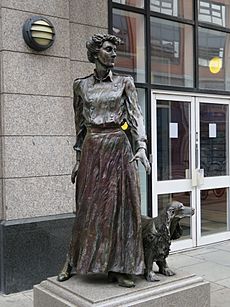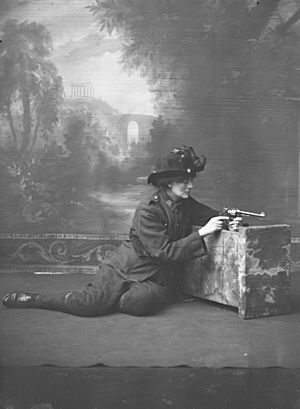Constance Markievicz facts for kids
Quick facts for kids
Constance Markievicz
|
|
|---|---|
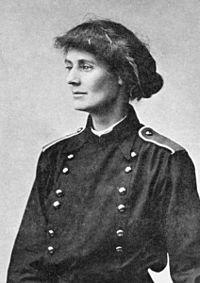
Constance Markievicz
|
|
| Member of Parliament | |
| In office 28 December 1918 – 15 November 1922 |
|
| Preceded by | William Field |
| Succeeded by | Constituency abolished |
| Constituency | Dublin St Patrick's |
| Teachta Dála | |
| In office August 1923 – 15 July 1927 |
|
| In office May 1921 – June 1922 |
|
| Constituency | Dublin South |
| In office December 1918 – May 2021 |
|
| Constituency | Dublin St Patrick's |
| Minister for Labour | |
| In office April 1919 – January 1922 |
|
| Preceded by | New office |
| Succeeded by | Joseph McGrath |
| Personal details | |
| Born |
Constance Georgine Gore-Booth
4 February 1868 London, England |
| Died | 15 July 1927 (aged 59) Dublin, Ireland |
| Resting place | Glasnevin Cemetery, Dublin, Ireland |
| Political party |
|
| Spouse | Casimir Markievicz (m. 1900) |
| Relations | Eva Gore-Booth (Sister) |
| Children | Maeve Markievicz (1901–1962) |
| Parents |
|
| Military service | |
| Allegiance |
|
| Years of service | 1913–1923 |
| Rank | Lieutenant |
| Battles/wars | |
Constance Georgine Markievicz (also known as Countess Markievicz) was an important Irish politician and revolutionary. She was a strong supporter of Irish nationalism and socialism. She also fought for women's right to vote.
Constance Markievicz made history as the first woman ever elected to the UK Parliament. She was also the first female cabinet minister in Europe. She served as the Minister for Labour in the First Dáil, which was the first parliament of the revolutionary Irish Republic.
She helped start important groups like Fianna Éireann, Cumann na mBan, and the Irish Citizen Army. She played a key role in the Easter Rising in 1916. This was when Irish republicans tried to end British rule and create an independent Irish Republic.
Contents
Early Life and Family
Constance Georgine Gore-Booth was born in London in 1868. Her father, Sir Henry Gore-Booth, 5th Baronet, was an explorer and landlord in Ireland. He owned a large estate in County Sligo.
During a difficult time in Ireland (the famine of 1879–80), her father gave free food to the people living on his land. This act of kindness deeply influenced Constance and her younger sister, Eva Gore-Booth. They both grew up caring a lot about working people and those who were poor.
The sisters were friends with the famous poet William Butler Yeats. He often visited their family home, Lissadell House. Yeats even wrote a poem about them, describing them as "two girls in silk kimono, both beautiful." Eva later became involved in movements for workers' rights and women's right to vote in Britain.
Becoming an Artist and Getting Married
Constance wanted to become a painter. She studied art in London at the Slade School of Art in 1892. While there, she became interested in politics and joined a group that supported women's right to vote.
Later, she moved to Paris to study at the Académie Julian. There, she met Casimir Markievicz, an artist from a wealthy Polish family. They married in London in 1900. Their daughter, Maeve, was born in 1901. Maeve was mostly raised by Constance's parents.
In 1903, the Markieviczes moved to Dublin. Constance became known as a talented landscape painter. She helped start the United Arts Club in 1905, which brought together artists and writers in Dublin. Through this group, she met many people interested in Irish culture and independence.
In 1907, Constance read revolutionary journals that supported Ireland's independence from British rule. These writings inspired her to become actively involved in politics.
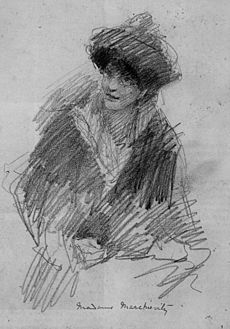
Early Political Actions
In 1908, Markievicz joined Sinn Féin, a political party working for Irish independence. She also joined Inghinidhe na hÉireann ('Daughters of Ireland'), a women's revolutionary group. She even acted in plays at the Abbey Theatre, which was important for Irish cultural pride.
She also actively supported women's right to vote. In 1908, she famously drove an old-fashioned carriage with four white horses to campaign against a politician who opposed women's suffrage. When someone asked if she could cook, she cleverly replied, "Yes. Can you drive a coach and four?"
In 1909, Markievicz founded Fianna Éireann. This was a nationalist scouting group for teenage boys. It taught them scouting skills and promoted Irish independence.
Her first time in prison was in 1911. She was arrested for speaking at a large protest against the visit of King George V to Ireland. She handed out leaflets and tried to burn a large British flag.
Markievicz later joined James Connolly's socialist Irish Citizen Army (ICA). This group was formed in 1913 to protect workers during the Dublin Lockout, a major industrial dispute. She helped feed poor children and workers, even using her own money and selling her jewellery to buy food.
In 1913, Casimir Markievicz moved back to Ukraine. They remained in contact, and he was with her when she passed away in 1927.
Markievicz once gave advice to women in a magazine: "Dress suitably in short skirts and strong boots, leave your jewels in the bank and buy a revolver." This showed her strong, practical, and revolutionary spirit.
The Easter Rising
As a member of the Citizen Army, Markievicz took part in the Easter Rising in 1916. She was greatly inspired by the leader of the ICA, James Connolly. She even designed the Citizen Army uniform and wrote its anthem.
During the Rising, Markievicz was involved in fighting in St Stephen's Green in Dublin. She helped set up barricades and was in the middle of the action. The Citizen Army troops held out for six days. They only surrendered when they received the order from Patrick Pearse.
After the surrender, Markievicz was taken to Kilmainham Gaol. She was the only one of the women prisoners placed in solitary confinement. At her trial, she said, "I went out to fight for Ireland's freedom and it does not matter what happens to me. I did what I thought was right and I stand by it."
She was sentenced to death, but her sentence was changed to life in prison because she was a woman. When she heard this, she famously said, "I do wish your lot had the decency to shoot me."
Markievicz was moved to prisons in England. She was released in 1917 as part of a general pardon for those involved in the Rising. Around this time, she converted to Catholicism.
First Dáil and Minister for Labour
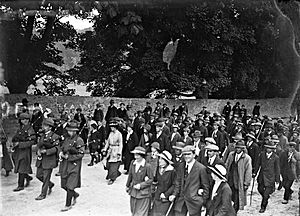
In 1918, Markievicz was jailed again for protesting against conscription (forced military service). In the 1918 Irish general election, she was elected to represent Dublin St Patrick's. She won with 66% of the votes.
This made her the first woman ever elected to the United Kingdom House of Commons. However, because of Sinn Féin's policy, she did not take her seat in the British Parliament. Instead, she and other Sinn Féin elected members formed the First Dáil, which was the parliament of the new Irish Republic.
Markievicz was in prison when the First Dáil first met in Dublin. When her name was called, it was announced that she was "imprisoned by the foreign enemy." She was re-elected to the Second Dáil in 1921.
From April 1919 to January 1922, Markievicz served as the Minister for Labour. This made her the first Irish female Cabinet Minister and only the second female government minister in Europe. Her department worked on solving worker disputes and setting guidelines for wages and food prices.
Civil War and Fianna Fáil
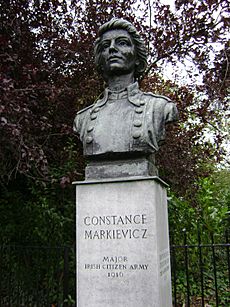
In January 1922, Markievicz left the government. She disagreed with the Anglo-Irish Treaty, which created the Irish Free State. She actively supported the side that opposed the Treaty in the Irish Civil War.
After the Civil War, she visited the United States. She was not elected in the 1922 election but won a seat for Dublin South in 1923. Like other Republican candidates, she did not take her seat in the Dáil. She was arrested again in November 1923 and went on hunger strike until she was released.
In 1926, she left Sinn Féin and helped create the Fianna Fáil party. She led the first meeting of the new party. In the June 1927 election, she was re-elected to the Dáil for Fianna Fáil. However, she passed away just five weeks later, before she could take her seat.
Death and Legacy
Constance Markievicz died on 15 July 1927, at the age of 59. She had given away most of her money and died in a public hospital ward, choosing to be "among the poor where she wanted to be."
The Free State government did not allow a state funeral for her. However, thousands of people in Dublin came to pay their respects. Her funeral procession was very long, showing how much she was loved by the people. Éamon de Valera, a future President of Ireland, gave the speech at her funeral.
Her friend and fellow revolutionary, the playwright Seán O'Casey, said of her: "One thing she had in abundance—physical courage; with that she was clothed as with a garment."
Tributes
In 2018, a painting of Markievicz was given by the Irish parliament to the British House of Commons. This was to celebrate the 1918 law that allowed some women the right to vote for the first time in the United Kingdom.
In 2019, a special plaque was put up at Markievicz's former home in Dublin to remember her.
See also
 In Spanish: Constance Markievicz para niños
In Spanish: Constance Markievicz para niños


